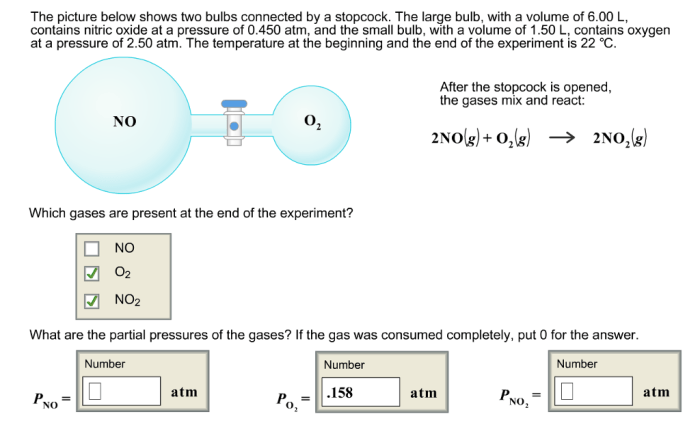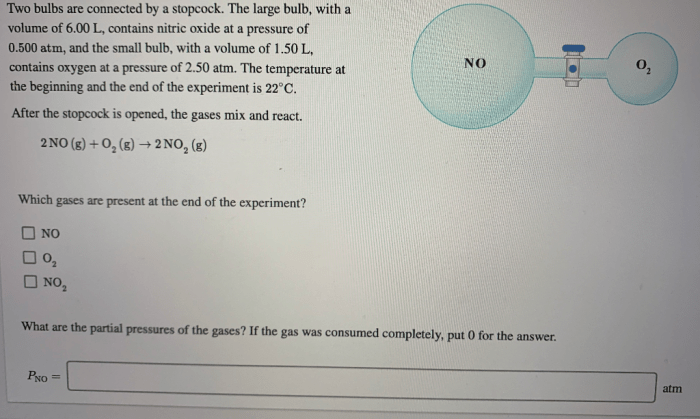Two bulbs are connected by a stopcock – Two bulbs connected by a stopcock: a seemingly simple apparatus that unlocks a world of scientific inquiry. This connection, a staple in laboratory experiments, offers a unique window into the fascinating interplay between pressure, volume, and gas behavior.
As we delve into the intricacies of this connection, we will unravel its practical applications, explore its variations, and address potential troubleshooting and safety considerations. Join us on this captivating journey as we illuminate the scientific principles that govern this ingenious device.
Two Bulbs Connected by a Stopcock

Two bulbs can be connected by a stopcock, which is a valve that allows gas to flow between the bulbs. The stopcock has three positions: open, closed, and partially open. When the stopcock is open, gas can flow freely between the bulbs.
When the stopcock is closed, gas cannot flow between the bulbs. When the stopcock is partially open, gas can flow between the bulbs, but at a reduced rate.

Pressure and Volume Changes
When the stopcock is open, the pressure in both bulbs will be the same. This is because gas can flow freely between the bulbs, and the pressure will equalize. When the stopcock is closed, the pressure in the two bulbs will be different.
The pressure in the bulb that contains more gas will be higher than the pressure in the bulb that contains less gas. This is because the gas in the bulb with more gas is more compressed.
The relationship between pressure and volume in the connected bulbs is described by Boyle’s law. Boyle’s law states that the pressure of a gas is inversely proportional to its volume. This means that as the volume of a gas increases, its pressure decreases.
Conversely, as the volume of a gas decreases, its pressure increases.
Applications of the Stopcock Connection, Two bulbs are connected by a stopcock
The stopcock connection is used in a variety of laboratory experiments and real-world applications. Some examples include:
- Measuring the volume of a gas: The stopcock connection can be used to measure the volume of a gas by connecting the bulbs to a graduated cylinder. The gas is then allowed to flow into the graduated cylinder, and the volume of the gas is measured.
- Determining the pressure of a gas: The stopcock connection can be used to determine the pressure of a gas by connecting the bulbs to a manometer. The pressure of the gas is then measured by observing the difference in height between the two columns of mercury in the manometer.
- Mixing gases: The stopcock connection can be used to mix gases by connecting the bulbs to each other. The stopcock is then opened, and the gases are allowed to flow into each other. The mixed gas can then be used in a variety of experiments.
Variations of the Stopcock Connection
There are a variety of different types of stopcocks that can be used to connect bulbs. Some of the most common types include:
- Straight stopcock: A straight stopcock has two ports that are connected by a straight channel. When the stopcock is open, gas can flow freely between the two ports. When the stopcock is closed, gas cannot flow between the two ports.
- Three-way stopcock: A three-way stopcock has three ports that are connected by two channels. The stopcock can be used to connect three different bulbs or to connect a bulb to a vacuum pump. The stopcock can also be used to isolate one of the bulbs from the other two.
- Four-way stopcock: A four-way stopcock has four ports that are connected by three channels. The stopcock can be used to connect four different bulbs or to connect a bulb to a vacuum pump and a gas source. The stopcock can also be used to isolate one of the bulbs from the other three.
In addition to these basic types of stopcocks, there are also a variety of specialized stopcocks that are designed for specific applications. For example, there are stopcocks that are designed to withstand high pressures or temperatures, and there are stopcocks that are designed to be used with corrosive gases.
Troubleshooting and Safety Considerations
There are a few potential issues that may arise when using a stopcock connection. These issues include:
- Leaks: Leaks can occur at the connection between the stopcock and the bulbs. Leaks can be caused by a variety of factors, including improper assembly, damage to the stopcock or the bulbs, or the use of incompatible materials.
- Clogging: The stopcock can become clogged with dirt or debris. Clogging can prevent gas from flowing through the stopcock, and it can also cause the stopcock to become difficult to operate.
- Corrosion: The stopcock can corrode over time, especially if it is exposed to corrosive gases. Corrosion can damage the stopcock and make it difficult to operate.
To avoid these issues, it is important to use the stopcock connection properly and to maintain it regularly. The stopcock should be assembled carefully and inspected for leaks before use. The stopcock should also be cleaned and lubricated regularly to prevent clogging and corrosion.
FAQ Insights: Two Bulbs Are Connected By A Stopcock
What is the purpose of connecting two bulbs with a stopcock?
Connecting two bulbs with a stopcock allows for the controlled manipulation of pressure and volume within the bulbs, enabling the study of gas behavior and the relationship between these variables.
How does the stopcock affect the pressure and volume of gases in the bulbs?
Opening the stopcock allows gases to flow between the bulbs, equalizing their pressure. Closing the stopcock isolates the bulbs, allowing for independent manipulation of pressure and volume in each bulb.
What are some applications of the stopcock connection?
The stopcock connection finds applications in various fields, including gas chromatography, vacuum filtration, and the study of gas properties in laboratory experiments.

